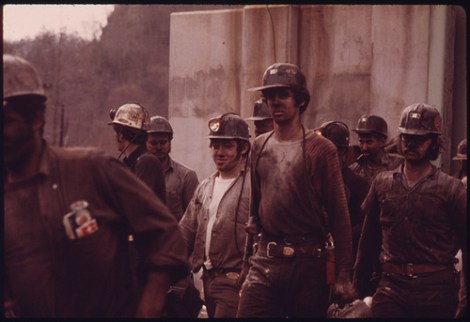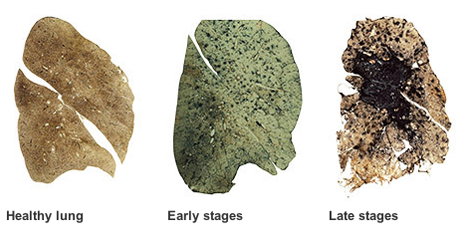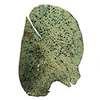In February 1969, miners in West Virginia launched an illegal wildcat strike. The action halted extraction for half of the mines in the northern part of the state for days. The miners had one demand: end black lung disease.
The action worked. By the end of 1969, new policies went into effect in an effort to curb the disease, which results from the inhalation of coal dust and leads to long-term lung damage and impaired breathing. New exposure limits were set, and miners were offered regular chest X-rays and compensation for damage. Donald Rasmussen, a pulmonologist in West Virginia interviewed by NPR, has tested tens of thousands of miners over the past half-century.
“In 1969, I publicly proclaimed that the disease would go away before we learned all about it,” he adds. “And I was dead wrong.”

Photo courtesy of the National Archives.
New research into the disease by NPR and the Center for Public Integrity reveals that black lung is far from eradicated. The CPI’s iWatch News summarizes their findings:
- After decades of decline, black lung is back. Its resurgence is concentrated in central Appalachia. Younger miners are increasingly getting the most severe, fastest-progressing form of the disease.
- The system for monitoring miners’ exposure to the dust that causes black lung allows companies to cheat or exploit loopholes. From 2000 to 2011, the federal Mine Safety and Health Administration, MSHA, received more than 53,000 valid samples showing an underground miner had been exposed to more dust than was allowed, yet the agency issued just under 2,400 violations. This may be attributable, in part, to rules that allow samples to be averaged, potentially masking some miners’ high exposures.
- Even when companies get caught, they have little to fear. They can take five of their own dust samples to prove compliance, and an MSHA citation goes away. The agency has routinely given companies extra time to fix cited dust problems, granting extensions in 57 percent of cases between 2000 and 2011.
- Miners have been exposed for years to excessive amounts of toxic silica dust, generated when powerful machines cut through rock. In each of the past 25 years, the average valid silica sample was above the allowed limit.
As always, though, the personal anecdotes are the most compelling aspect of the journalism. We won’t excerpt them here; go read them.
The key takeaway is simple: Critical protections for miners’ health have been dismantled or postponed through the concerted efforts of the mining industry and their allies on Capitol Hill. A companion report in the Charleston Gazette outlines four decades of obstruction:
For more than a quarter-century, government efforts to end deadly black lung disease have hit various brick walls, built by opposition from one side or the other. …
When Newt Gingrich and the Republicans took over the House of Representatives [in 1995], among their government streamlining proposals was to eliminate MSHA. Mine safety duties would be given instead to the Occupational Safety and Health Administration, weakening the greater protections federal law gives to miners. [Then-MSHA chief Davitt] McAteer and other top Labor Department officials spent years fighting the change. They eventually won, but the damage to their agenda — including black lung reforms — was significant.
Even today, elected officials — including the ones representing those most impacted by the disease — are quick to embrace the industry while being slow to address its impacts.
This morning, The Hill posted an interview with Rep. David McKinley (R-W. Va.), a first-term member of the House and unabashed champion of coal use. McKinley offers no critique of the coal industry: no mention of pollution from coal-burning power plants, no mention the health of the miners. Instead, he argues that the government should regulate fossil fuels less than it currently does.

The impact of black lung. (Image courtesy of NIOSH.)
“If the people here in Congress would just back off their attack on fossil fuels and industry and manufacturers and pay a little bit more attention to what goes on in our homes and our offices, perhaps we would have a more healthy work environment rather than attacking our job creators,” McKinley said.
With tongue in cheek, McKinley suggests that the government might be just as well served addressing the contents of apple juice as regulating fossil fuels.
In the meantime, here’s what’s happening to his constituents:
A wake-up call for some came after the Upper Big Branch explosion in southern West Virginia in April 2010, which killed 29 miners. Of the 24 who had enough lung tissue for an autopsy, 17 had signs of black lung. Some had fewer than 10 years of experience in mines; they ranged in age from 25 to 61.
The disease leaves miners’ lungs scarred, shriveled and black. They struggle to do routine tasks and are eventually forced to choose between eating and breathing.
“No human being should have to go through the misery that dying of [black lung] entails,” said Dr. Edward Petsonk, who treats patients with black lung and works with NIOSH. “It is like a screw being slowly tightened across your throat. Day and night towards the end, the miner struggles to get enough oxygen. It is really almost a diabolical torture.”




